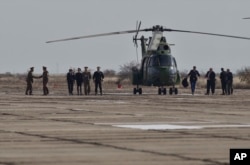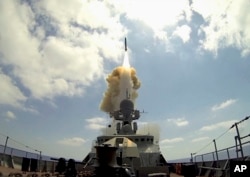Russian President Vladimir Putin made the new accusation speaking at a session of the Russian Ministry of Defense on December 22, adding that “the target-missiles used to test its antiballistic missile systems are identical to intermediate-range and shorter-range ballistic missiles.”
“They are already available and are being used. Their production in the U.S. can attest to the development of technologies banned by the INF treaty,” RT quoted him as saying. The 1987 treaty is regarded as symbolic of the easing of tensions as the Cold War wound down.
Putin’s comment comes days after he made the same accusation during his annual news conference on December 14. He said then that the United States had deployed ABM (antiballistic) systems in Romania that he claimed could be converted to offensive uses. He further accused the U.S. of engaging in propaganda “for a possible U.S. withdrawal from this Treaty."
He argued that it is easy to replace the defensive Aegis missiles, built originally to intercept a shipboard attack. The Aegis missiles installed in Romania are adapted for land-based defense. Russia claims they can be converted to intermediate-range attack missiles. This would violate the INF treaty and, by implication, threaten Russia’s security.
Under the Treaty, the United States and Russia are required “to eliminate and permanently forswear” nuclear and conventional ground-launched ballistic and cruise missiles of specified ranges. Considered a major milestone in the international security framework that “reduced threats of surprise and preemptive attack,” the INF provided for the destruction of some 2,692 intermediate-range nuclear-armed missiles. The destroyed systems reportedly included the Soviet SS-20, the American Pershing II, and an American ground-launched cruise missile. As the two nuclear powers pared down their nuclear arsenals, the INF is seen as the nuclear treaty that contributed to international security in the years after the collapse of the Soviet Union.
According to Scott Ritter, a former U.S. intelligence officer who dealt with the implementation of arms control treaties during the Cold War, Moscow appears keen to provoke the United States to withdraw from the treaty – a move Washington “appears only too willing to consider.”
The United States and Russia have accused each other of violating the treaty on multiple occasions. Besides the deployment of Aegis interceptors, Moscow points to the U.S. drone program as an example of the treaty violations and has on numerous occasions claimed that the United States has failed to present evidence and specific examples of Moscow’s own violations.
In a series of latest declarations on the issue, Russian Foreign Ministry spokesperson Maria Zakharova made this statement a day prior to Putin’s news conference: “I would like to remind that the Americans do not present a single scrap of evidence for their allegations [against Russia]. They simply cannot present it because such evidence fundamentally does not exist.”
Russian Foreign Minister Sergei Lavrov similarly dismissed the allegations of violations, stating last March: “There have been no violations on our part. The U.S. claims otherwise, without providing any specific information that could be verified in order to clarify the situation.”
Contrary to the statements by the high-ranking Russian officials, U.S. officials have not acted to leave the treaty, though some have called for it.
Moreover, the United States has detailed the allegations of Russia’s violations numerous times.
According to the Arms Control Association, in 2014 the U.S. State Department alleged in a report Russia’s violations of the treaty “not to possess, produce, or flight-test a ground-launched cruise missile with a range capability of 500 km to 5,500 km, or to possess or produce launchers of such missiles.” The department reportedly repeated its allegations in 2015, 2016, and 2017.
In 2015, U.S. Under Secretary of Defense for Policy Brian McKeon in his statement on the issue to the U.S. Congress stated that the evidence of Russia’s violations was “conclusive,” adding that “Russia has tested this ground-based system well into the ranges covered” by the treaty.
“We are talking about a real system and not a potential capability,” he stressed, referring to a Russian cruise missile that U.S. officials dubbed the SSC-X-8. Russia tested it in 2014, and allegedly deployed one of the two missile battalions at a test site near Volgograd.
Christopher Ford, Special Assistant to the President and Senior Director for Weapons of Mass Destruction and Counterproliferation on the National Security Council, confirmed the name of the missile on November 29 while speaking at the Washington, D.C.-based Wilson Center.
Speaking on Russia’s alleged violations, NATO’s Supreme Allied Commander Gen. Curtis M. Scaparrotti stated in March 2017 that “Russia’s fielding of a conventional/nuclear dual-capable system” banned under the treaty “creates a mismatch in escalatory options with the West.”
However, in his July testimony, Vice Chairman of the Joint Chiefs of Staff General Paul J. Selva stated that the Russian system, which allegedly violates the treaty, does not provide Russia with a special military advantage “given the location of the specific missiles and deployment.”
Thomas Karako, International Security Program and Director of the Missile Defense Project at the Washington-based Center for Strategic and International Studies, wrote in 2014 that both the Russian and the U.S. press had provided reports covering Russia’s alleged violations.
“On the basis of extensive classified information and confirmation by the Departments of State and Defense, the House of Representatives in May declared Russia in ‘material breach’ of the treaty,” he wrote, quoting former U.S. Ambassador to Ukraine Steven Pifer suggesting Russia’s INF missile tests were part of a “disturbing pattern of disregard for international agreements.”
Referencing 2013 report by STRATCOM and the Joint Chiefs examining U.S. “capability gap” under the INF, Karako argues that Washington needs to consider its options if the treaty lapses in 2021 in order to address threats from intermediate-range systems of Iran, North Korea, and China, and Russia. Such options, he specified, include deployments of improved Army Tactical Missile Systems, Multiple Launch Rocket Systems, as well as the Vertical Launch Systems.
On the other hand, Russia accuses the United States of violating the treaty by deploying the Mark 41 Vertical Launch System (VLS), a component of a missile defense system capable of launching offensive missiles. Russia further alleges that the United States has relied on banned missiles in its missile defense tests while contending some of its armed drones represent banned cruise missiles.
However, U.S. officials argue that the INF allows systems created only for intercepting “objects not located on the surface of the earth,” such as the Aegis missile system.
Vladimir Leontiev, deputy head of the Russian Foreign Ministry’s non-proliferation and arms control department, said in June that “threatening actions” by the U.S. in the context of the INF treaty would lead to counter-measures by Russia to “restore the military balance.”
A November article in the Arms Control Today quoted Putin as saying that Russia might be “tempted” to break the treaty if it did not have its air- and sea-based missiles matching U.S. capabilities. The INF, it notes, “left both countries free to deploy air- and sea-launched missiles” with a range of 500 to 5,500 kilometers, a range the INF covers for the land-based missiles.
The article quotes Putin warning of an “immediate and reciprocal” response if the United States withdraws from the treaty: “You can see how effective the Kalibr missiles are, from the Mediterranean Sea, from the Caspian Sea, from the air or from submarines, whatever you wish,” he said. “Besides Kalibr, with an operational range of 1,400 kilometers, we have other airborne missile systems, very powerful ones with an operational range of 4,500 kilometers.”
The article notes that some Republican lawmakers, including Senator Tom Cotton (R-Ark.), reportedly advocate for the U.S. withdrawal from the treaty and that, according to U.S. officials, the United States provided “some specifics” of Russia’s violations of the treaty in November 2016. This came weeks after Putin criticized Washington for “refusing to specify” its allegations.
On December 8, 2017, the U.S. Department of State issued a statement underscoring U.S. firm commitment to the INF Treaty but emphasizing that it seeks Russia’s “return to compliance” and that it “cannot stand still” while Russia develops systems that are violating the treaty.
“While the United States will continue to pursue a diplomatic solution, we are now pursuing economic and military measures intended to induce the Russian Federation to return to compliance. This includes a review of military concepts and options, including options for conventional, ground-launched, intermediate-range missile systems, which would enable the United States to defend ourselves and our allies, should the Russian Federation not return to compliance. This step will not violate our INF Treaty obligations,” it said. It added that Washington is ready to stop its activities if Russia complies with the INF fully and verifiably.












